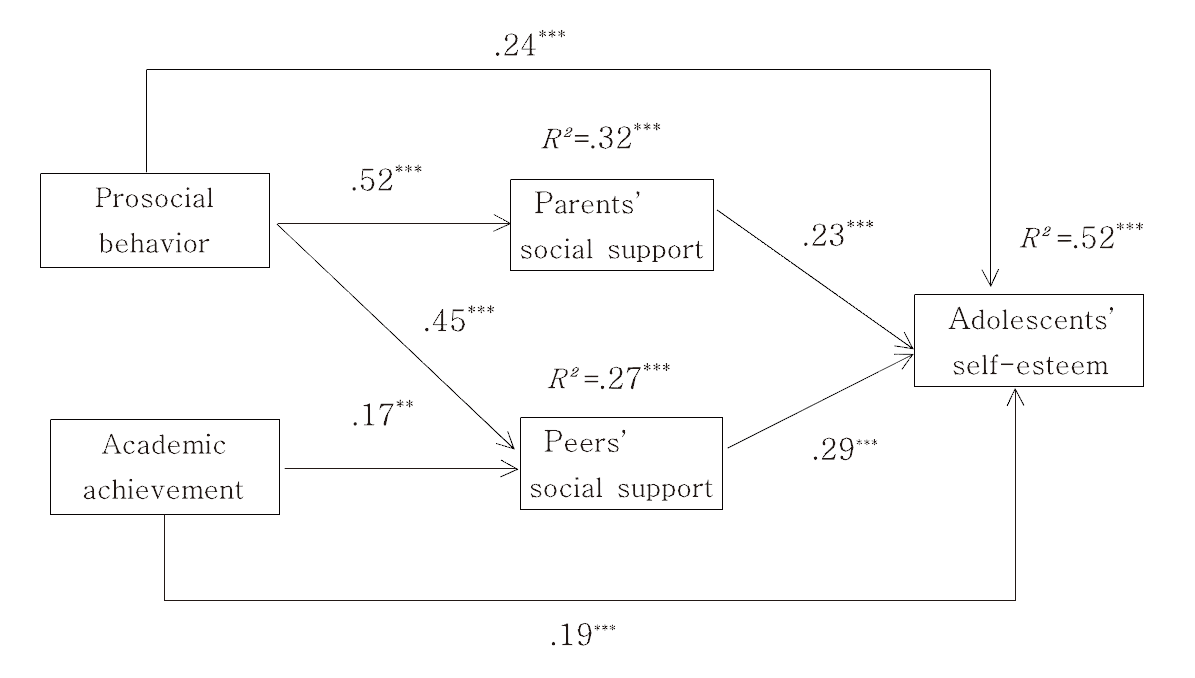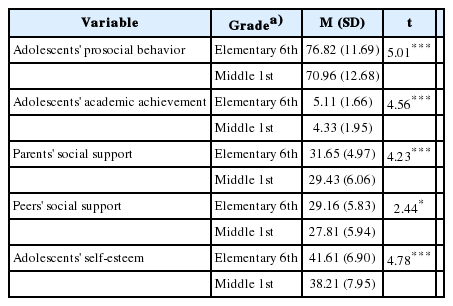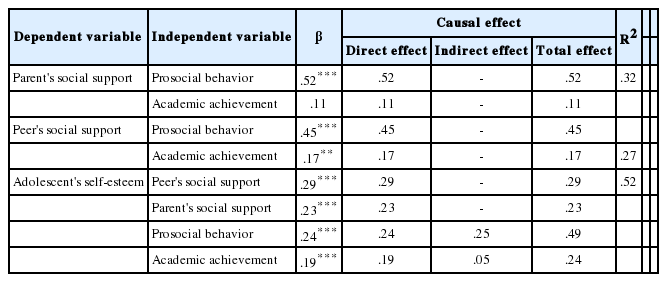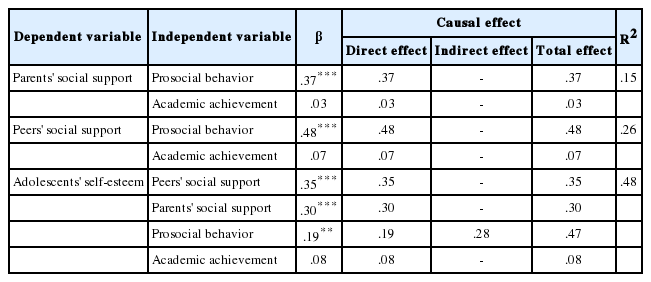초기 청소년의 학년에 따른 개인적 변인, 사회적 지지와 자아존중감 간의 인과적 관련성
The Causal Relationship of Early Adolescents’ Personal Variables and Social Support on Self-Esteem According to Grade
Article information
Trans Abstract
The purpose of this study was to investigate the causal relationship of early adolescents’ personal variables and social support on their self-esteem by grade. Information on 226 6th graders from elementary schools and 226 1st year students from middle schools in Busan was collected. Early adolescents’ prosocial behavior, academic achievement, social support, and self-esteem were assessed using their self-reports. For the data analysis, Cronbach’s a, t -test, Pearson’s correlation coefficient, and multiple regression were used. The collected data were analyzed by the SPSS ver. 21.0 program for Windows. The major findings were as follows: first, early adolescents’ prosocial behavior, academic achievement, social support demonstrated a significant difference between grades. Second, peers’ social support was the most powerful determinant of self-esteem in both the 6th graders from elementary schools and the 1st year middle school students. Third, prosocial behavior had the greatest total effect on self-esteem in the case of both groups of students. The middle schoolers’ academic achievement had no causal effect on their self-esteem. The findings from this study indicate that early adolescents’ personal variables and social support are important elements that affect their self-esteem differently depending on their grade. Further, the findings of this study can be used as fundamental data to develop a teaching plan and provide counseling for early adolescents in order to increase their self-esteem.
서론
자아존중감은 자신의 가치에 대해 스스로 내리는 평가적 감정이다[50, 54]. 자아존중감이 높은 아동과 청소년은 자신을 유능하게 지각하고 자신에 대해 만족하므로 사회적 적응을 잘하고 심리적 안녕감이 높다[36, 63].
자아존중감은 유아기에 가장 높다가 학령기 초기에 점차 하락한다[64, 81]. 그 이유는 유아기에는 부모의 무조건적 지지로 자아존중감이 높지만 학령기이후가 되면 아동이 자신의 능력, 행동, 외모 등을 다른 사람과 비교하는 사회적 비교를 하기 때문이다. 그러다 학령기 4, 5학년부터 다시 자아존중감은 서서히 상승을 한다[84]. 그러나 청소년초기의 자아존중감 수준은 사춘기적 발달특성과 중학교 진학이라는 상황적 특성이 맞물려 안정성을 유지하지 못한다.
청소년 초기는 신체적으로 빠른 성숙으로 외모에 관심이 높아지고[32, 53] 인지적으로는 추상적 사고로 전환된다. 이에 따라 독립과 자율 욕구가 증가한다[49]. 이렇게 발달적으로 불안정한 시기에 새로운 중학교 진학은 심리적 스트레스와 긴장을 유발하여 자아존중감을 일시적으로 감소시킨다[7, 18, 28, 38, 78, 80]. 중학교 진학 전후 학년은 유사한 청소년초기에 속하지만 자아존중감에서 차이를 보이므로 중학교 진학 전후로 학년을 구분하여 연구를 수행할 필요가 있다. 그러나 초기청소년의 자아존중감 연구에서 중학교 진학전후로 구분하는 것은 간과된 경향이 있다.
자아존중감 형성에 대한 이론적 배경은 Cooley의 면경자아이론에서 출발한다. 아동은 유아기부터 사회적 상호작용을 통해 중요타인의 평가를 내면화하여 자아존중감을 발달시킨다[42]. 유아기와 아동기의 자아존중감에는 부모 평가의 영향이 크지만 초기 청소년기는 부모와의 정서적 분리가 시작되면서 또래가 중요타인이 된다. 그러나 자아존중감에 미치는 부모의 인정은 청소년기까지 감소하지 않으며[39] 부모는 자아형성에서 지속적으로 중심적 역할을 한다.
초기 청소년의 자아존중감 예측요인은 자아존중감 형성의 이론적 배경에다 사춘기적 발달특성, 중학교 진학이라는 상황적 특성을 반영할 필요가 있다. 청소년은 자의식이 강해지면서 타인의 평가에 민감해진다[76]. 사회적 지지는 개인이 그가 가진 대인관계로부터 얻을 수 있는 모든 긍정적인 심리적 자원으로[15] 초기 청소년기에도 중요타인의 평가로 간주된다[40]. 사회적 지지는 중요타인으로부터 관심과 인정, 사랑과 신뢰 등을 받는 것을 포함하므로[52] 좌절과 변화에 대해 인내하고 극복하는 능력을 증진시킨다[83]. 사회적 지지는 특히 중학교 진학에 따른 긴장과 불안을 완화하여 자아존중감을 높인다[21, 29].
사회적 지지 가운데 특히 또래지지는 긴장과 스트레스로부터 청소년들을 보호해주며 진학 후의 대처능력을 향상시키는 데 도움이 된다[5, 17, 41, 57]. 미국 중서부 지역에서 실시된 실증적 자료에서 중학교 진학 전후 모두 또래지지와 자아존중감은 유의미한 관련이 있었다[44]. 최근 Scotland 연구에서 중학교 진학에 따른 또래관계 걱정은 자아존중감과 부적 관련이 있었다[79].
초기 청소년기가 되면서 부모지지보다 또래지지 영향이 높아진다고 주장하지만[16, 21] 실제로 Canada 연구에서 중학교 진학 후 부모지지는 감소하지 않았다[7]. New England 지역에서 실시된 연구에서 중학교 진학 전에 측정한 부모지지는 중학교 진학 전후의 전반적 자아가치와 관련이 있었다[6]. 오히려 중학교 진학 후에 자아존중감에 대한 부모지지의 영향이 또래지지의 영향보다 더 크다는 증거들도 있다[29, 37, 55, 68]. 이와 같이 또래지지와 부모지지는 모두 초기청소년의 자아존중감에 직접적 영향을 미친다.
학령기 이후의 자아존중감 형성은 타인평가의 영향뿐만 아니라 사회적 비교과정을 통해 이루어지는 자신의 유능성에 영향을 받는다[19, 37]. 중학교 진학은 생애전환기 사건으로 청소년은 학업과제가 어려워지고 새로운 우정과 소속감 요구라는 도전을 받는다. 사회적지지 외에도 또래 및 학업유능성의 개인적 변인은 이러한 도전에 대처자원이 되므로 이 시기 청소년의 자아존중감을 높이는 예측요인이 된다[4, 8, 14, 26, 29, 62].
Fenzel [29]의 연구에서 중학교 진학 전후 자아존중감 변화에 가장 큰 영향을 미친 변인은 사회적 유능성이었으며 자아존중감과 사회적 유능성은 정적 상관이 가장 높았다. 사회적 유능성으로 간주되는 사회적 기술이 잘 발달되어 있는 청소년들은 중학교 진학 후 적응을 더 잘하는 경향이 있으며 진학에 대한 대처에 도움을 주므로[25] 자아존중감에 정적 영향을 미친다는 증거들이 있다. 국내에서 실시된 Chung [12]의 연구에서 중학교 진학전후 사회적 기술과 자아존중감은 정적 관련이 있었다. 그런데 청소년기는 도덕적인 사람이 되는 것을 자랑스럽게 여기는 도덕적 자아가 아동기보다 발달하므로[24, 27, 65, 82] 자아존중감 향상에는 단순히 관계를 형성·유지하는 기술인 사회적 기술보다도 친사회적 행동이 유리하다. 친사회적 행동은 협동, 공감, 양보, 나누기 같은 타인에게 이익을 주는 모든 자발적인 행동으로 정의된다[22]. 다수연구에서 청소년의 친사회적 행동과 자아존중감은 직접적 관련이 있었다[23, 34, 47, 51, 61]. 그러나 중학교 진학 관련연구에서 자아존중감에 대한 친사회적 행동의 영향이 간과되었다.
우리사회는 대학진학중심의 교육풍토여서 학업성취를 강조하고 청소년 또한 주된 관심사이다[35, 68]. 뿐만 아니라 학업성취와 관련된 경험이 청소년들에게 자랑스러운 성공경험으로 인식된다[69]. Fenzel [29]의 연구에서 중학교 진학 전후 자아존중감에 사회적 유능성 다음으로 학업유능성이 높은 상관이 있었다. 학업 능력이 있는 학생은 그렇지 못한 학생보다 중학교 진학 후 심리적 적응이 유리하였다[2, 9].국내의 경험적 연구에서도 학업성취는 자아존중감에 직접적 영향을 미친다[56, 66, 68].
단순히 자아존중감 예측요인만을 확인하는 것은 초기청소년을 수동적으로 간주하므로[72] 매개과정을 포함할 필요가 있다. Harter [38]는 처음에는 개인적 유능성과 사회적 지지가 각각 독립적으로 자아존중감에 직접적인 영향을 미치는 모형을 제시했다. 그러나 초기청소년은 무조건적 지지를 받는 유아기 때와 달리 조건적인 사회적 지지를 받기 위해서는 개인적 유능성이 부모와 또래의 기준을 충족시킬 수준이 되어야 한다. 즉, 유능성이 높아도 사회적 지지를 받지 못하면 자아존중감은 향상되지 못할 수 있다. Harter [41]는 이러한 점을 반영하여 개인적 유능성은 사회적 지지를 매개하여 자아존중감에 간접적 영향을 미치는 경로를 연구에 포함시켰다. Harter가 설정한 경로는 강하게 입증되었다. 청소년 발달학자들에 따르면 사회적 지지를 받는 청소년의 특성은 친사회적이고 학업성취가 높다[5, 41, 43, 74]. Harter의 연구 결과와 청소년발달학자들의 주장을 종합하면 친사회적 행동과 학업성취의 개인적 변인은 사회적 지지에 영향을 미침을 시사한다.
친사회적 행동은 전통적으로 부모지지와 관련되지만[20] 청소년기에 또래지지와 밀접한 관련이 있는 행동특성이며[51] 또래괴롭힘, 외로움, 사회적 불안을 완화하므로[70, 77] 부모지지보다 친구지지와 더 관련이 높음을 제시한다[33, 60]. 친사회적 행동은 중학교 진학전에는 자아존중감에 대한 부모지지를 매개한 간접적 영향이, 중학교 진학 후에는 또래지지를 매개한 간접적 영항이 더 클 것으로 예상이 된다.
청소년은 학업성취의 부담으로 스트레스를 경험하기도 하므로 학업성취가 자아존중감에 긍정적인 영향만을 주지는 않는다. 사회적 지지는 학업스트레스를 완화하면서 희망과 심리적 안녕을 부여한다[10, 66]. 특히 전통적으로 부모와 같은 성인지지는 학업관련 긴장에 유리한 지지를 제공한다[5, 41, 43]. 최근 Ryan [74]은 초기 청소년의 학업성취에 또래관계가 결정적 역할을 한다고 주장한다. 따라서 학업성취는 부모의 격려와 지지뿐만 아니라[11, 45, 58], 또래지지를 매개하여[1, 46] 자아존중감에 간접적인 영향을 미친다.
즉, 청소년의 사회적 지지와 개인적 변인은 자아존중감에 직접적으로도 영향을 미치지만 개인적 변인은 부모나 또래가 인정해주고 지지해주어서 자아존중감이 높아지므로 사회적 지지를 매개하여 자아존중감에 간접적인 영향도 미친다는 인과적 관련성을 가정할 수 있다.
초기 청소년발달에서 또래의 영향을 강조하는 학자들은[5, 29, 30, 38] 중학교 진학 후에는 또래의 영향이 커지므로 또래관련 요인이 자아존중감에 대한 설명력을 높인다고 주장한다. 반면, 학업성취는 부모나 교사의 주된 관심사이므로[73] 중학교 진학 후 청소년의 자아존중감에 대한 영향이 오히려 감소하였다[3, 29, 55, 74]. 이와 같이 중학교 진학 전후 학년 간 자아존중감에 대한 관련요인의 상대적 영향의 차이로 인해 자아존중감에 대한 관련변인의 인과적 관련성은 중학교 진학 전후로 다를 것으로 예상된다. 자아존중감에 대한 관련요인의 인과적 관련성을 중학교 진학 전후 학년 간 비교분석함은 학년에 따른 자아존중감 발달과정의 차이를 보다 상세히 이해하게 된다. 그리하여 심리적으로 취약한 청소년을 확인하고 이 시기 청소년의 심리적 적응을 도모할 수 있다.
본 연구의 목적은 초기청소년의 자아존중감에 대한 사회적 지지와 개인변인의 직접효과와 개인변인의 사회적 지지를 매개한 간접효과를 학년에 따라 비교분석하고자 한다. 그리고 이보다 앞서 학년에 따른 연구변인들의 차이를 알아보아서 중학교 진학에 따른 연구변인들의 일반적 경향을 파악하고자 한다.
본 연구의 실제적 목적은 중학교 진학 전후 초기청소년의 자아존중감을 향상시키는 방안을 도모하고 자아존중감 향상 프로그램을 개발할 때 기초자료를 제공할 수 있을 것이다.
연구문제
1. 중학교 진학 전 청소년의 개인변인, 사회적 지지, 자아존중감 수준은 중학교 진학 후보다 높게 나타나는가?
2. 초기 청소년의 친사회적 행동, 학업성취의 개인적 변인은 사 회적 지지를 매개하여 자아존중감에 영향을 미치는가? 이것은 학년에 따라 달리 나타나는가?
연구방법
1. 연구대상
본 연구의 대상은 부산시 3개구에 소재한 1개의 초등학교 7학급과 2개의 중학교 각 3, 4학급 총 14학급을 대상으로 임의추출한 남녀학생 452명이다. 연구대상을 초등 6학년과 중학 1학년으로 설정한 이유는 초등학교 6학년은 자아존중감이 안정적이고, 중학교 1학년은 학교진학을 경험한 직후 학년이어서 자아존중감이 민감하게 변화하기 때문이다.
연구대상 청소년의 인구통계학적 특성이 Table 1에 제시되어 있다.
조사대상자의 특성 및 인구통계학적 배경에 대해 살펴보면, 남아 228명(50.4%), 여아 224명(49.6%)으로 남아가 더 많았으며, 학년별 구성에 있어서는 초등학교 6학년이 226명(50.0%), 중학교 1학년이 226명(50.0%)이었다. 부모의 학력은 아버지의 경우 대졸이 250명(55.3%)으로 가장 많았고, 어머니의 학력도 대부분 대졸 이상이었다(259명, 57.3%). 아버지의 직업분포를 보면, 전문관리직이 180명(39.8%)으로 가장 많았고, 어머니의 직업분포의 경우 주부가 185명(40.9%)으로 가장 많은 비율을 차지하고 있는 것으로 나타났다. 한편, 가정의 월수입은 301만원 이상이 229명(50.6%)으로 가장 많았다.
2. 연구도구
1) 자아존중감
초기청소년의 전반적 자아존중감을 측정하기 위해 10문항으로 구성된 Rosenberg [71]의 전반적 자아존중감 척도를 사용하였다. Rosenberg [71]의 전반적 자아존중감은 ‘나는 적어도 다른 사람들만큼 가치있는 사람이라고 생각한다,’ ‘나는 자랑할 만한 것이 별로 없다,’ ‘나는 중요한 사람이라는 생각이 든다’의 문항으로 구성된다. 각 문항의 응답범주는 ‘거의 그렇지 않다’ 1점에서 ‘매우 그렇다’ 5점으로 전체점수는 10점에서 50점 사이다. 점수가 높을수록 전반적 자아존중감이 높음을 의미한다. 본 연구에서 척도의 신뢰도 계수 Cronbach α 값은 .91이다.
2) 사회적 지지
초기 청소년이 지각하는 사회적 지지를 측정하기 위해 Park[67]이 개발한 척도를 사용하였다. Park [67]의 ‘사회적지지’척도 중 부모와 또래의 정서적지지 7문항을 사용하였다. Park [67]의 부모지지는 ‘우리 부모님은 내가 사랑과 보살핌을 받고 있다고 느끼게 해준다,’ ‘우리 부모님은 함께 있으면 친밀감을 느끼게 해준다’의 문항으로 구성된다. Park [67]의 또래지지는 ‘내 친구들은 내가 마음놓고 의지할 수 있는 사람이라고 생각한다,’ ‘내 친구들은 항상 나의 일에 관심을 갖고 걱정해 준다고 생각한다.’의 문항으로 구성된다. 각 문항의 응답범주는 ‘거의 그렇지 않다’ 1점에서 ‘매우 그렇다’ 5점으로 점수범위는 7점에서 35점이다. 점수가 높을수록 사회적 지지가 높음을 의미한다. 본 연구에서 척도의 신뢰도 계수 Cronbach α 값은 부모지지는 .95, 또래지지는 .93이다.
3) 친사회적 행동
초기 청소년의 친사회적 행동을 측정하기 위해 Lee [59]의 아동용 친사회적 행동 척도를 사용하였다. Lee [59]의 친사회적 행동척도는 Eisenberg의 이타성 자기보고를 기초로 한 Yang의 척도를 수정 보완한 것이다. 이 척도는 도움주기, 나누기, 위안하기, 협동하기의 4개 영역, 총 20문항으로 이루어져 있다. 본 연구에서 사용한 친사회적 행동척도는 ‘나는 친구가 별로 없는 아이와 놀아 준 적이 있다,’ ‘나는 다른 친구가 나의 물건을 사용하려고 하면 빌려준다,’ ‘나는 다른 친구가 도와달라고 할 때 도와주려고 애쓴다’ 등으로 문항이 구성된다[59]. 각 문항의 응답범주는 ‘거의 그렇지 않다’ 1점에서 ‘매우 그렇다’ 5점으로 점수범위는 20점에서 100점이다. 점수가 높을수록 친사회적 행동이 높음을 의미한다. 본 연구에서 척도의 신뢰도 계수 Cronbach α 값은 .90이다.
3. 연구절차
초등학교 7학급과 중학교 7학급의 총 478명 청소년 전체에 대해 담임교사가 종례후에 자아존중감과 관련변인에 대한 질문지를 조사하였다.
자료수집은 2013년 7월 13-19일에 걸쳐 조사를 실시하였다. 회수된 질문지 478부 중 문항에 대한 응답이 누락됐거나 불성실한 질문지를 제외한 총 452부를 최종분석 자료로 사용하였다.
4. 자료분석
본 연구의 자료들은 IBM SPSS ver. 21 (IBM Co., Armonk, NY, USA) 통계 프로그램을 사용하여 분석하였다. 먼저 척도의 신뢰도 검증을 위해 Cronbach’s α 계수를 산출하였다.
연구문제1에서 학년에 따른 연구변인들의 차이를 알아보기 위하여 t-test를 실시하였다. 연구문제2에서 청소년의 개인적 변인이 사회적 지지를 매개하여 자아존중감에 영향을 미치는지 알아보기 위해 학년에 따라 다중회귀분석을 통해 경로분석을 실시하였다.
연구결과
1. 초기청소년의 학년에 따른 연구변인의 차이
초기청소년의 학년에 따른 개인변인, 사회적지지, 자아존중감의 차이를 알아보기 위해 t-test를 실시한 결과를 Table 1에 제시하였다.
Table 2의 결과에 따르면 초기청소년의 친사회적 행동(t=.5.01, p<.001), 학업성취(t=4.56, p<.001), 부모지지(t=4.23, p<.001), 또래지지(t=2.44, p<.05), 자아존중감(t=4.78, p<.001)은 초등 6학년이 중학 1학년보다 유의미하게 높은 점수를 보였다.
2. 청소년의 학년에 따른 자아존중감에 대한 관련변인의 인과적 관련성
1) 청소년의 연구변인들 간의 상관관계
청소년의 자아존중감에 대한 관련변인의 인과적 관련성을 알아보기 전에 연구변인들간의 적률상관계수를 알아보기 위해 이변량 상관분석을 실시한 결과를 Table 3에 제시하였다.
Table 3에 의하면 종속변인인 청소년의 자아존중감과 독립변인들 간의 상관은 초등 6학년의 경우 r=.25-.59의 범위에 있고 중학 1학년의 경우 r=.25-.58의 범위에 있다. 초등 6학년의 자아존중감과 독립변인간의 상관을 크기순으로 보면, 또래지지, 친사회적 행동, 부모지지, 학업성취 순으로 유의미한 정적 상관관계가 나타났다. 중학 1학년의 자아존중감과 독립변인간의 상관을 크기 순으로 보면, 또래지지, 부모지지, 친사회적 행동, 학업성취 순으로 유의미한 정적 상관관계가 나타났다.
2) 청소년의 학년에 따른 자아존중감에 대한 관련변인의 인과적 관련성
청소년의 학년에 따른 자아존중감에 대한 개인변인과 사회적 지지의 인과적 관련성를 알아보기 위해 자아존중감을 종속변인으로 하고 개인변인을 독립변인으로, 부모지지와 또래지지를 매개변인으로 하여 순차적 다중회귀분석을 실시하였다.
우선 초등 6학년의 다중회귀분석 및 인과효과분석 결과를 Table 4와 Figure 1로 제시하였다.

The causal relationship of elementary 6th grader's personal variables and social support with self-esteem.
Table 4와 Figure 1에 의하면, 부모지지(β=.23, p<.001)와 또래지지(β=.29, p<.001)는 자아존중감에 직접적인 영향을 미쳤다. 개인변인 중 친사회적 행동은 자아존중감에 직접적인 영향(β=.24, p<.001)을 미칠 뿐 아니라 부모지지(β=.52, p<.001)와 또래지지(β=.45, p<.001)를 통해 간접적인 영향을 미쳤다. 학업성취는 자아존중감에 직접적인 영향(β=.19, p<.001)을 미칠 뿐 아니라 또래지지를 통해 간접적인 영향(β=.17, p<.05)을 미치는 것으로 나타나 본 연구에서 설정한 가설이 부분적으로 지지되었다.
초등 6학년 청소년의 자아존중감에 대한 관련변인들의 인과효과 분석에 의하면, 청소년의 자아존중감에 직접적인 영향을 미치는 변인은 부모지지, 또래지지, 친사회적 행동, 학업성취이고 간접적인 영향을 미치는 변인은 친사회적 행동, 학업성취이다. 초등 6학년 청소년의 자아존중감에 대한 관련변인의 직접효과와 간접효과를 합한 총효과를 크기순으로 살펴보면, 친사회적 행동(.49), 또래지지(.29), 학업성취(.24), 부모지지(.23)의 순으로 나타났다.
다음으로 중학 1학년의 다중회귀분석 및 인과효과분석 결과를 Table 5와 Figure 2로 제시하였다.

The causal relationship of middle school 1st grader's personal variables and social support with self-esteem.
Table 5와 Figure 2에 의하면, 부모지지(β=.30, p<.001)와 또래지지(β=.35, p<.001)는 자아존중감에 직접적인 영향을 미쳤다. 개인변인 중 친사회적 행동은 자아존중감에 직접적인 영향(β=.19, p<.001)을 미칠 뿐 아니라 부모지지(β=.37, p<.001)와 또래지지(β=.48, p<.001)를 통해 간접적인 영향을 미쳤다. 학업성취는 자아존중감에 직접적인 영향 뿐 아니라 부모지지와 또래지지를 통한 간접적인 영향도 미치지 않는 것으로 나타나 본 연구에서 설정한 가설이 부분적으로 지지되었다.
중학 1학년 청소년의 자아존중감에 대한 관련변인의 인과효과 분석에 의하면, 초기 청소년의 자아존중감에 직접적인 영향을 미치는 변인은 또래지지, 부모지지, 친사회적 행동이고 부모지지와 또래지지를 통한 간접적인 영향을 미치는 변인은 친사회적 행동이다. 중학 1학년 청소년의 자아존중감에 대한 관련변인의 직접효과와 간접효과를 합한 총효과를 크기순으로 살펴보면, 친사회적 행동(.47), 또래지지(.35), 부모지지(.30), 학업성취(.08)의 순으로 나타났다.
논의 및 결론
본 연구는 중학교 전환기 청소년들의 자율욕구는 증가하는 데 반해 중학교 진학이라는 도전적 경험이 심리적 긴장을 유발하여 자아존중감이 변화한다는 근거 하에 자아존중감에 대한 관련요인의 인과적 관련성이 중학교 진학 전후로 차이가 있는지 알아보기 위해 실시되었다. 중학교 진학 전후 학년인 초등 6학년과 중학 1학년을 대상으로 자아존중감과 관련변인의 수준 차이, 자아존중감에 대한 개인변인과 사회적 지지의 직접효과 및 개인변인이 사회적 지지를 매개한 간접효과를 분석하는 것이 본 연구의 목적이었다.
이러한 연구목적에 따라 연구 결과를 요약하고 논의하면 다음과 같다.
먼저 청소년의 학년에 따른 연구변인들의 수준을 학년별로 비교하면 청소년의 친사회적 행동, 학업성취, 부모지지, 또래지지, 자아존중감은 초등 6학년이 중학 1학년보다 유의미하게 높은 점수를 보였다. 중학 1학년 청소년의 자아존중감과 연구변인 수준이 감소한 것은 중학교 진학은 청소년에게 도전적 경험이 되어 자아존중감을 비롯하여 부모지지, 또래지지, 친사회적 행동, 학업성취 수준을 하락시킨다는 선행연구결과와 일치한다[7, 13, 14, 31, 48, 55, 75, 79, 80]. 그러나 중학교 진학 후 대부분의 연구변인이 증가하였다는 Fenzel [29]의 연구결과와는 일치하지 않았는데, Fenzel [29]의 연구에서는 유의미한 상승은 아니며 자아존중감 외 척도가 본 연구와는 달랐다
둘째, 초기 청소년의 자아존중감에 대한 개인변인과 사회적 지지의 인과적 관련성을 학년별로 분석한 결과는 다음과 같다.
청소년의 자아존중감에 대한 관련변인의 인과적 관련성에서 초등 6학년과 중학 1학년 모두 부모지지와 또래지지는 직접적인 영향을 미쳤다. 개인변인 중 친사회적 행동은 자아존중감에 직접적으로도 영향을 미치지만 또래지지와 부모지지를 매개하여 간접적인 영향을 미쳤다. 학업성취는 초등 6학년의 경우만 자아존중감에 대한 직접적 영향과 또래지지를 매개한 간접적 영향을 미치는 것으로 나타났다. 중학 1학년의 경우는 자아존중감에 대한 학업성취의 직접적 영향 및 사회적 지지를 매개한 간접적 영향이 나타나지 않아서 본 연구에서 설정한 가설이 부분적으로 지지되었다. 이러한 연구결과는 Harter [41]가 제시한 수정모형과도 부분적으로 일치한다. Harter [38]는 처음에는 아동과 청소년의 자아존중감에 사회적 지지와 역량지각이 각각 직접적인 영향만을 미치는 모형을 제시했다가, 이후에 사회적 지지와 역량지각은 자아존중감에 직접적으로도 영향을 미치지만 학업역량과 품행역량은 부모지지를, 외모와 또래역량은 또래지지를 매개하여 간접적인 영향을 미친다는 모형으로 수정한 바 있다[41].
청소년의 자아존중감에는 중학교 진학 전후 학년 모두 또래지지가 가장 직접적인 영향력이 있어서 이들의 심리적 적응에 또래지지가 강력한 보호요인으로 작용함을 시사한다. 본 연구의 결과는 또래지지는 학교에서의 사회적 적응과 관련된 긴장을 완화하는 요인임을 강조한 선행연구[5, 41, 43]나 사회적 지지 가운데 특히 또래들로부터 받는 지지는 스트레스로부터 청소년들을 보호해주며 진학 후의 대처능력을 향상시키는데 도움이 된다고 제시한 Compas [17]의 연구를 지지한다. Fenzel [29]의 연구에서 전환기 청소년의 자아존중감 변화에 친구의 지지와 사회적 유눙성이 가장 높은 설명력을 가진다는 결과와도 같은 맥락이다. 중학교 전환기에는 친구를 만들고, 친구로부터 인정과 지지를 받는 것이 심리적 적응을 위해서는 무엇보다 유리하다고 제안할 수 있다. 본 연구에서 자아존중감에 대한 사회적 지지의 영향 중 부모지지보다 또래지지가 더 크게 나타난 것은 아동기 후반에는 부모보다 또래의 영향이 더 크다는 선행연구들의 주장과 일치한다[11, 14]. 또래지지 다음으로 부모지지의 영향이 높게 나타나서 전환기 청소년의 자아존중감에는 사회적 지지의 영향이 개인의 유능성보다 더 크게 나타났다. 이것은 중학교 진학 전후 모두 사회적 지지와 자아존중감의 관련성이 높게 나타난 Chung [12]의 연구결과와 일치한다고 볼 수 있다.
초등 6학년과 중학 1학년 모두 자아존중감에 대한 친사회적 행동의 직접효과와 간접효과를 합친 총효과가 가장 큰 것으로 나타났는데 이는 친사회적 행동이 중학교 진학 전후 모두 청소년의 자아존중감에 가장 설명력이 높음을 시사한다. 또한, 중학교 진학 전후 모두 자아존중감에 대한 친사회적 행동의 직접효과보다 사회적 지지를 매개한 간접효과가 더 큰 것으로 나타났다. 이는 친사회적 행동 자체로도 자아존중감을 높이지만 친사회적 행동을 부모나 또래가 인정하고 지지해줄 때 자아존중감이 더 높아진다고 해석할 수 있다. 청소년기는 도덕적 자아가 발달하고[82] 본 연구에서 자아존중감에 대한 친사회적 행동의 영향이 큼에도 불구하고 이제까지 경험적 연구는 간과되었다.
중학교 진학 전의 친사회적 행동은 또래지지보다 부모지지에 대한 영향이 더 크고 중학교 진학 후의 친사회적 행동은 부모지지보다 또래지지에 대한 영향이 더 크다. 이것은 학령기는 친사회적 행동이 부모지지와 관련되며 중학교 진학 후에는 친사회적 행동이 또래지지와 더 관련있다는 선행연구와 일치한다[33, 60].
개인변인 중 학업성취는 초등 6학년의 경우는 자아존중감에 직접적으로 영향을 미치고 또래지지를 통해 간접적인 영향을 미치는 반면, 중학 1학년의 경우는 자아존중감에 대한 직접적 영향 및 부모지지와 또래지지를 매개한 간접적인 영향이 나타나지 않았다.
중학 1학년의 자아존중감에 학업성취가 직간접적 영향을 미치지 않은 점은 자아존중감과 학업자아 간의 관계가 중학교 진학 후 약화되었다는 선행연구결과[3, 29, 55, 74]와 일치하지만 중학 1학년의 자아존중감에 학업성취가 영향을 미친 Park [68]의 연구결과와는 일치하지 않는다. 이것은 중학 1학년의 경우 학업성취가 중요하지만 아직 학업성적이 확정되지 않아 자아존중감에 영향을 미치지 않을 수도 있다. 또는 학업성취는 일부 청소년에게는 자아존중감을 높이는 요인이기도 하지만 일부청소년에게는 학업성취가 스트레스원이거나 심리적 부담으로 작용하여 자아존중감을 낮추는 요인이 되기도 한다. 본 연구결과에서는 이것이 혼잡되어 나타나서 자아존중감에 대한 학업성취의 영향이 다른 변인보다 상대적으로 약화되어 사라진 것으로 해석할 수 있다.
이상의 논의를 토대로 전환기 청소년의 자아존중감을 향상하기 위해서는 다음과 같이 제안할 수 있다. 우선 자아존중감에 사회적 지지가 직접적으로 영향을 주므로 부모는 지지를 강화하고 청소년 개인적으로는 친사회적 행동을 많이 하여 부모지지와 또래지지를 많이 받도록 권장하는 개입전략이 필요하다. 학교에서는 친사회적 행동 향상프로그램을 중학교 전환기 준비교육에 반영할 필요가 있다. 중학교 진학 후 청소년에게 부모와 교사는 지나치게 학업성취를 강조하지 말아야 하며 우리 사회도 대학진학중심 교육풍토에서 벗어나 건강한 청소년 문화조성을 하여야한다.
본 연구결과에 의거하여 다음과 같은 결론을 내리고자 한다. 첫째, 중학 1학년은 초등 6학년에 비해 연구변인들의 수준이 낮다. 둘째, 초기 청소년의 자아존중감에 대한 관련변인의 인과적 관련성은 중학교 진학 전후 모두 사회적 지지는 직접적 영향을 미치고 그 중 또래지지의 직접적 영향이 가장 크다. 친사회적 행동은 전환기 청소년의 자아존중감에 가장 설명력이 높고 직접효과보다 사회적 지지를 매개한 간접효과가 더 크다. 중학교 진학 전에는 학업성취가 자아존중감에 직접적 영향과 또래지지를 매개한 간접적 영향을 미치나 중학교 진학 후에는 자아존중감에 대한 학업성취의 직간접효과는 없다.
본 연구결과는 전환기 청소년의 자아존중감에 대한 관련변인의 인과적 관련성을 중학교 진학 전후로 비교분석하여 자아존중감을 향상시키는 요인과 발달과정의 차이에 대해 보다 상세한 설명을 할 수 있는 근거를 제공하였다. 전환기 청소년 중 자아존중감이 취약한 학생을 확인하고 이들의 자아존중감 향상을 위한 개입과 프로그램의 기초자료를 제공하였다는 데 의의가 있다.
본 연구의 제한점은 다음과 같다. 첫째, 부산지역 일부 초등 및 중학교를 대상으로 하여 연구결과를 일반화시키는데 한계가 있다. 둘째, 본 연구결과는 중학교 진학 전후 학년의 자아존중감 관련요인을 한 시점에서만 측정하여 분석한 횡단적 접근에 머물렀다. 추후연구에서 중학교 진학 전후 시점으로 나누어 종단적 접근을 한다면 자아존중감 관련요인간의 인과적 관계가 보다 명확해질 것이다. 셋째, 본 연구에서는 전환기 청소년의 보호요인에 해당하는 변인들만 연구되었고 전환기의 긴장과 스트레스와 같은 변인을 포함하지 않은 한계점을 갖는다. 추후 연구에서는 이러한 변인들도 고려한다면 전환기 청소년의 심리적 적응에 대한 설명력을 높일 수 있을 것이다.
Notes
The authors declared that they had no conflicts of interests with respect to their authorship or the publication of this article.
Acknowledgements
This work was supported by a 2-Year Research Grant of Pusan National University.




